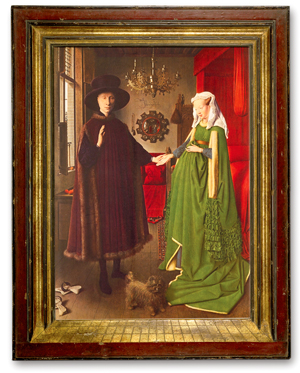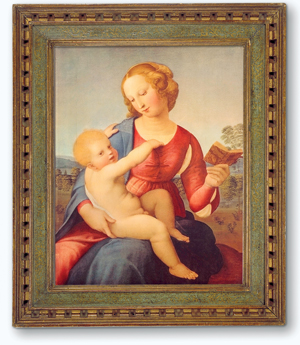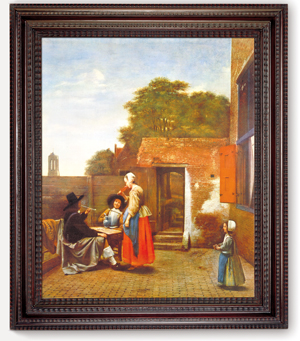Frames > More about framing > Frames à l'Ancienne: some historical background information
some historical background information
From time immemorial, frames have responded to artists’ need to provide a well-defined space for their created images. The frame therefore marks the border between the represented object and reality, between the divine work and the work of men.
Hints of frames dating back to ancient times were found around mosaics and the decorative borders enclosing wall frescoes. At Pompeii, some of the pictures painted on the walls as trompe l’oeil seem to be surrounded by beading and are shown as being suspended by a cord.
At the start of our era, regular lines were drawn around the edges of the wall paintings in the catacombs of Rome and during the IVth century, the painted frame became decorated with plant-like patterns. Symbolic subjects appeared in Constantinople. The borders around the icons from this period actually foreshadowed the wooden frames of religious paintings in the Middle Ages.
The development of the frame is closely linked to the history of art and has thus been influenced by all of the main artistic movements. The Romanesque period and its miniatures gave us the legacy of drawn frames showing tracery or esoteric compositions with very precise meanings; these frames were always produced in colours that blended in with the work of art itself. These rich decorations were later to inspire craftsmen to create picture frames.

At first, Middle age painting settled for plain rectilinear profiles, but Gothic style replaced these austere mouldings with frames inspired by architecture, gilded in the same manner as the paintings themselves. As in the cathedrals, the retables (altarpieces) were surrounded by pilaster arches and archivolts.
In the 16th century the Florentine master Antonio Barile, produced his carved masterpiece: the round “tondo” frame with polychrome flowers.
Finally, in the last stage before the Classical period, the Renaissance movement perpetuat- ed the Gothic tradition.
During this period, parts of existing monuments were sometimes copied or the frames were an extension of the painting itself thanks to the trompe l’oeil effect.
Image: Jan van Eyck - The Portrait of Giovanni Arnolfini and his Wife
Frame: Van Eyck (The Primitive)
In the 16th century the Florentine master Antonio Barile, produced his carved masterpiece: the round “tondo” frame with polychrome flowers.
Finally, in the last stage before the Classical period, the Renaissance movement perpetuat- ed the Gothic tradition.
During this period, parts of existing monuments were sometimes copied or the frames were an extension of the painting itself thanks to the trompe l’oeil effect.
Image: Jan van Eyck - The Portrait of Giovanni Arnolfini and his Wife
Frame: Van Eyck (The Primitive)

However, in Italy, new types of frames were created; the most important type consisted of two curved mouldings surrounding a flat front strip decorated with polychrome motifs. This new arrival found its origins in the illuminations of Romanesque Irish manuscripts.
With the onset of the XVIIth century and the rapid expansion of framing, the central strip became the most popular model.
Corner and centre ornaments were invented by the Spanish and thanks to artistic competi- tion, carved Italian frames started appearing with ever bolder motifs.
The frame had to exude luxury, taste and meticulousness, as did the picture itself, and was either intended for the great and mighty of this world or in praise of divine glory. Creating frames was therefore entrusted to the best carvers, gilders and cabinetmakers.
Image: Raphaël - Colonna Madonna
Frame: Rafaëllo-vert (Italian Frames)
With the onset of the XVIIth century and the rapid expansion of framing, the central strip became the most popular model.
Corner and centre ornaments were invented by the Spanish and thanks to artistic competi- tion, carved Italian frames started appearing with ever bolder motifs.
The frame had to exude luxury, taste and meticulousness, as did the picture itself, and was either intended for the great and mighty of this world or in praise of divine glory. Creating frames was therefore entrusted to the best carvers, gilders and cabinetmakers.
Image: Raphaël - Colonna Madonna
Frame: Rafaëllo-vert (Italian Frames)

During this period, the Netherlands showed a preference for reverse profiles ornamented with guilloches ( a type of ripple moulding) or covered with tortoise shell, walnut burr, ash, rosewood or else frames produced using solid precious wood.
Image: Pieter de Hooch - A Dutch Courtyard
Frame: Terbrugghen-noyer (Dutch Frames)
Image: Pieter de Hooch - A Dutch Courtyard
Frame: Terbrugghen-noyer (Dutch Frames)



